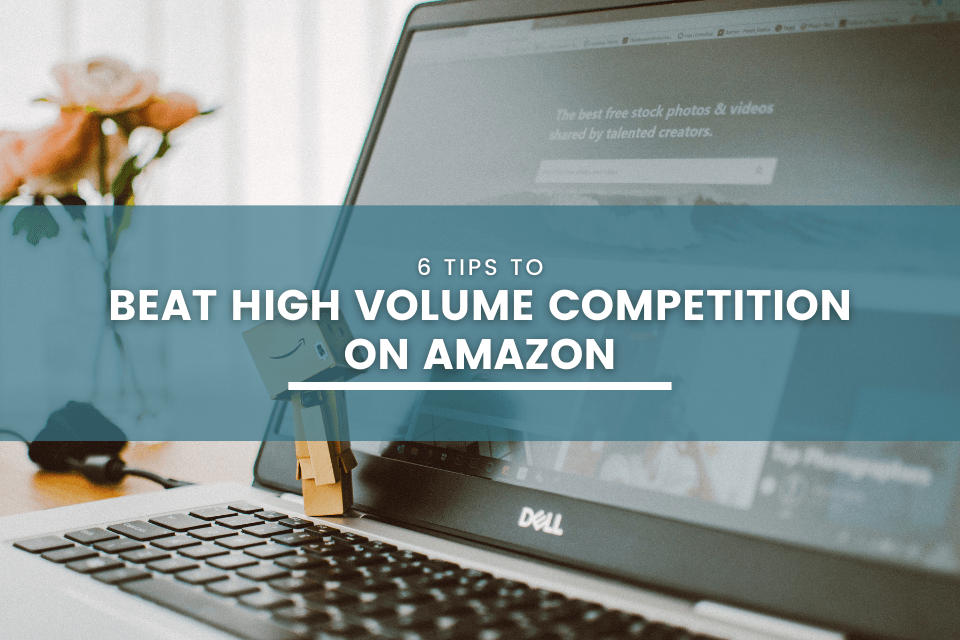This website uses cookies so that we can provide you with the best user experience possible. Cookie information is stored in your browser and performs functions such as recognising you when you return to our website and helping our team to understand which sections of the website you find most interesting and useful.
24 Jan

6 Tips To Beat High Volume Competition on Amazon
Amazon becomes the preferred eCommerce channel for more and more buyers, the competition amongst sellers continues to get increasingly fierce. To become and continue to be a successful seller on Amazon, you need to constantly outperform your competitors. However, it’s not just enough to have a great product. To be able to survive and succeed in the Amazonian Business Jungle, you need to have a soAs lid strategy in place to beat all competing players.
The most efficient way to make sure you stand out is by conducting a thorough competitor analysis. This will not only help you strategize to create a competitive advantage, but also increase your chances of rising up in the search rankings and secure higher sales.
In this blog, we reveal strategies that sellers must implement to carefully analyze their competitors and get a bigger share of the sales pie:
1) Identifying the right competitors: It is difficult to beat someone when you don’t know who you are competing against! There will broadly be two kinds of competitors for any product: i) Primary competitors – those selling the same product or targeting the same audience as yours; ii) Secondary competitors – those offering a higher or lower end version, but still solving a similar need as your product.
You may want to see how all the products from different brands are presented to a customer by entering highly relevant keywords in the search bar. However, seeing what comes up on top is not enough. You need to identify relevant competitors. These can be shortlisted on the basis of various factors like – intent of the product, price range, number of reviews, target audience, brand presence, etc. The underlying idea is that your competitors’ list will also keep on evolving as your business scales up on Amazon.
Another strategy that we like to use at Growisto is focusing on studying Amazon Brand Analytics data. We tap into these metrics to shortlist the top converting competitors.
2) Studying competitor’s product portfolio to develop new products: Once you have determined who your competitors are, you need to carefully study their product line to see what all is on offer. This would help you identify those products that are currently not available in your own portfolio, and can possibly be areas of missed opportunity for you to maximize your sales potential. Based on a host of factors like target audience for the product, it’s intent and usage, and feasibility of development, you can take a call on if you would want to launch this product as a part of your catalog on Amazon.
Another way to identify new product launch opportunities could be by mining the Amazon Brand Analytics data. This data can help you gather product ideas by analyzing what alternate products do users usually view and purchase, in place of your products. You could also study the “Frequently Bought Together” section of your competitor’s products to see what customers are usually interested in buying within the same or similar category.
3) Auditing competitor product listings: Ranging from the title and description, to the images, you must extensively work on understanding the attributes highlighted in the competitor’s product listings. You can begin by analyzing the title structure, note whether it is informational or promotional. Then analyze the advantages prioritized in product descriptions and bulletin features of top competitors. In the description, it is crucial to identify the USPs highlighted, and the pain points addressed. You can also audit the listings of the top players in your category to get further insights.
Want to go a step further? Browse the Q&A section of the competitor’s listing! Observe the kind of questions asked, the tone used, and the answers provided. What’s better than understanding demand and sentiment directly from the consumer themselves?
Furthermore, a thorough auditing of the product listings can give you a good understanding of the competitor’s keyword strategy as well. We suggest comparing your keyword rankings with those of your competitors, and repeating this strategy every few months to stay on the top of your game.
4) Assessing competitor prices and sales: 82% of US buyers state that pricing is the most important factor driving their purchase decision on Amazon. Hence, in order to fine-tune your pricing strategy, you should also be aware of the pricing mix of your competition.
We recommend setting alerts and monitoring your competitors’ pricing strategies. Keeping track of such price fluctuations can also help determine whether a competitor is underselling at any given point. You can then decide to counter them by reducing your own prices for a brief period of time, and avoid losing out on any conversions. Another good idea is to also keep a check on the promotional offers extended by your competitors from time to time.
Not just pricing changes, but what about changes in the sales velocity of your competitors? Would you not want to know if they are propelling their sales or actually losing out? We recommend tracking the Best Seller’s Ranking (BSR) to keep a track of such variations in the sales rates. You can also correlate changes in pricing to the BSR movement, and evaluate whether your competitors’ pricing strategies are working out for them.
5) Evaluating competitor’s advertising strategies: With a thorough understanding of your competitor’s ads strategy, you can ensure that you build a better one and beat them at their own game! You need to begin by studying the keywords that are targeted by your competitors in their ads. Check the search volume, suggested bids, and try to assess how competitive these keywords are. But how does this data help? You can:
- Identify keywords which are less competitive and tap them using ads immediately
- Identify keywords on which your close competitors are advertising, then target those aggressively to take their spot
- Identify keywords on which your competitors have bagged the Amazon’s Choice tag and bid on those aggressively
You can also target ASINs where you see a competitive advantage for yourself. Identify competitor products that are relevant to yours, and filter out those that are priced higher, or have fewer reviews than yours, or have poor quality listings. By outsmarting your competition this way, you are ultimately able to get a higher ROI out of your advertising strategy.
6) Monitoring competitor’s reviews: Keep a close track of your rival’s reviews, both in quality and quantity. Through this, a first-hand view of the shopper’s demands and needs can be acquired. Examining the reviews of a competitor’s products can give you an insight into the weaknesses and strengths of the product being sold by them. You can then work on improving your product’s quality too.
Moreover, you can also try to incorporate those features into your own product listings, that the customers liked in your competing products. You can highlight those qualities in your product listing, where your competition may be lagging behind. Make your product and listing better than your competitors, and you are already ahead in the race to maximize your sales potential! Furthermore, you can also track the rate of increase in the reviews of your competitors. This may give you an indication of the sales velocity of the product, and put you in a better position to also plan your strategies accordingly.
All in all, the entire process of monitoring and surpassing your competition may seem daunting. However, as sellers, you must actively focus on the aforementioned tips to propel your sales.
Industries Served
United States
India










